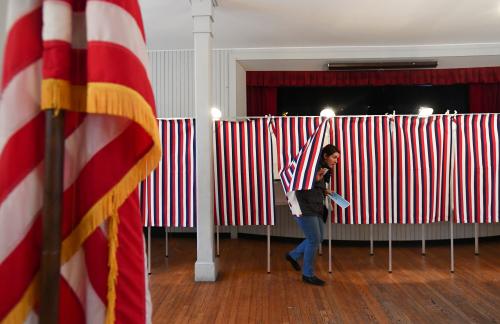In this series, we look at how younger voters are likely to impact future elections and American politics going forward.
The entry of minor parties into next year’s presidential election campaign raises two questions. The first — can minor parties win? — is easy to answer. Based on the historical record, they cannot. In some earlier elections that featured relatively strong third-party presidential candidacies (1912, 1948, 1968 and 1992) the winning candidate’s margin was wide enough that even the relatively large number of voters who cast ballots for the candidate they most preferred in those elections, without regard to that vote’s impact on the outcome of the election, was not enough to elect a third-party candidate for president.
The answer to the second — can minor parties affect the results of the 2024 presidential contest? — depends on how successful the nominees of the two major parties are in activating their coalitions and, as a result, how close the presidential contest appears to be as Election Day approaches.
Younger voters and third-party candidates
As with previous generations, younger voters have weaker partisan identifications than their parents and grandparents. A recent Pew survey found that younger Americans were more likely to hold negative views of both parties than older Americans. That’s particularly true among voters under 30 made up mostly of members of the Pluralist generation, often referred to as Gen Z, more than a third of whom viewed both parties negatively — more than twice the percentage of those aged 65 and over.
Furthermore, although today’s younger voters are more engaged in politics than today’s older generations were when they were young, their motivation to vote is driven more by issues and causes than partisan politics; more by their search for candidates who share their values than those who share their party affiliation.
In fact, right now, more than one in ten voters under 45 say there’s a good chance or greater chance that they would vote for whoever is on the presidential ticket for the No Labels initiative or for “independent” candidate Cornel West.
The platforms put forth by each of these alternatives, however, have views that conflict with those of a majority of voters under 45. As younger voters become more aware of the conflict between their own beliefs on some of these critical issues and those of a given third-party candidate, a smaller percentage of voters under 45 are less likely to cast what political scientists call a “sincere” vote, i.e., voting for the candidate they most prefer, regardless of that vote’s impact on the outcome of the election.
For example, the No Labels platform, Common Sense, suggests the need for striking “a balance between protecting women’s rights to control their own reproductive health and our society’s responsibility to protect human life.” This may sound like a reasonable compromise but to the two-thirds of younger voters, both men and women in all racial/ethnic groups, who want abortion to be legal, that “balanced” approach is likely to be perceived as restrictions on abortion access with which they do not agree.
In addition, reflecting its desire to attract Sen. Joe Manchin (D-WV) as its standard bearer, the No Labels platform fails to endorse the urgency and priority of dealing with climate change that younger voters feel strongly about. Its energy policy states, in part, that “fossil fuel energy is absolutely essential to our economy now and for the foreseeable future,” a position completely out of alignment with the beliefs of younger voters.
If anything, the campaign proposals from Cornel West, who has recently decided to run as an independent instead of as a Green Party candidate, are even more out of alignment with younger voters’ values and beliefs than the so called “Common Sense” platform positions of No Labels. West’s presidential campaign website begins with a call for “Vastly cutting back on military spending, dissolving non-defensive security alliances, including NATO and AUKUS.” To advocate such actions while NATO stands as the critical alliance for protecting the sovereignty of Ukraine is completely contrary to the priorities of voters under 45 who are more likely to support greater US support for Ukraine than older voters.
West’s promoting of ideas such as reducing spending on policing also does not mesh with the current attitudes of most young Americans. A 2021 Pew survey indicated that in the year following the murder of George Floyd there was 10-point rise in the percentage of those 18-49 who favored increased spending on policing (from 26% to 36%) and an 11-point decline (from 34% to 23%) in the percentage favoring a reduction.
Third-party candidates as spoilers
If Donald Trump is the Republican nominee, his presence on the 2024 ballot will make it more likely that a greater number of third-party voters will vote “strategically,” rather than “sincerely.” Research by political scientist Barry C. Burden defines strategic votes as those cast for a candidate that isn’t necessarily the voter’s first choice, but for the candidate who is perceived by the voter to have the best chance of beating another candidate in the race.1 While sincere votes are votes that reflect the candidate that voters truly want.
Strategic voting becomes more popular as election day draws near, and the status of the race becomes clearer. Studies of the 1992,1996 and 2000 presidential elections have shown that when voters cast their ballot strategically, minor candidates receive fewer votes than predicted by pre-election polls, and the two leading candidates receive almost all the votes in the election. By contrast, if voters feel it is safe to vote “sincerely” because the outcome of the election is not in doubt, minor party percentages are more likely to reflect earlier pre-election polling results.
So, even though history suggests support for presidential candidates nominated by third parties will never become large enough to win the White House, whether third-party support will shrink enough in 2024 to make votes for third party presidential candidates irrelevant to the outcome of the Electoral College depends on how competitive voters perceive the race between the two major party candidates to be. In fact, since the presidential election is really a state-by-state contest, the more a given state is considered a “battleground state” the less likely it is that a third-party candidacy will have an impact on the results in that state, and therefore the overall election outcome.
Still, given the narrow margins that President Biden won by in 2020, a rematch with Donald Trump might well make the results in a few battleground states close enough to make votes cast for Cornel West, Robert F. Kennedy or the No Labels’ candidate relevant. Some argue that the outcomes in the battleground states of Michigan, Wisconsin and Pennsylvania in 2016 were close enough (less than a percentage point in all three cases) that votes cast for the Green Party candidate, Jill Stein, elected Donald Trump president. Such an outcome, however, was only possible because almost no one, including Trump himself, thought Trump had a chance to win making it easier for voters in those states to vote “sincerely,” rather than “strategically”.
In 2024 the possibility of a Trump victory will not be as easily dismissed, nor will the implications be as uncertain as they were in 2016. Both of these conditions make it less likely a third-party candidate will impact the results in a battleground state. Still, the possibility of such an outcome was enough to cause former Green Party nominee Ralph Nader to say he would “help,” if not endorse, Joe Biden in 2024.
The impact of third-party candidates on the results of the 2024 presidential election will depend less on what the candidates of third parties say or do and more on the quality of the campaigns waged by the nominees of each major party. As we have written earlier in these pages, how successful the campaigns end up being will, in turn, depend to a great degree on how successful they are in engaging voters under 45 and convincing them that their votes will determine who will become President of the United States.
-
Footnotes
- Minor Parties and Strategic Voting in Recent US Presidential Elections, Barry Borden, Volume 4, Issue 4, December, 2005 pp. 603-618. Accessed at: https://www.sciencedirect.com/science/article/abs/pii/S0261379405000223








Commentary
How younger voters will impact elections: Responding to the challenges of third parties
October 19, 2023